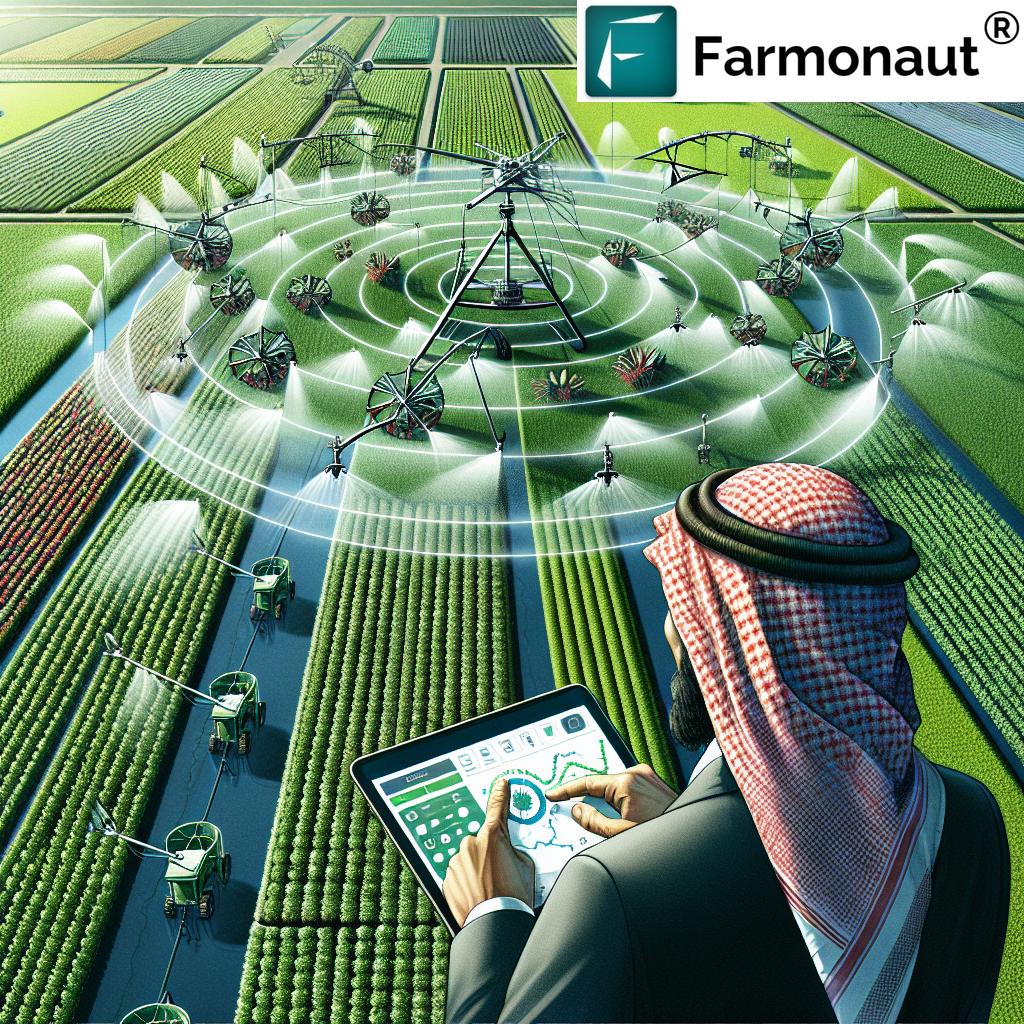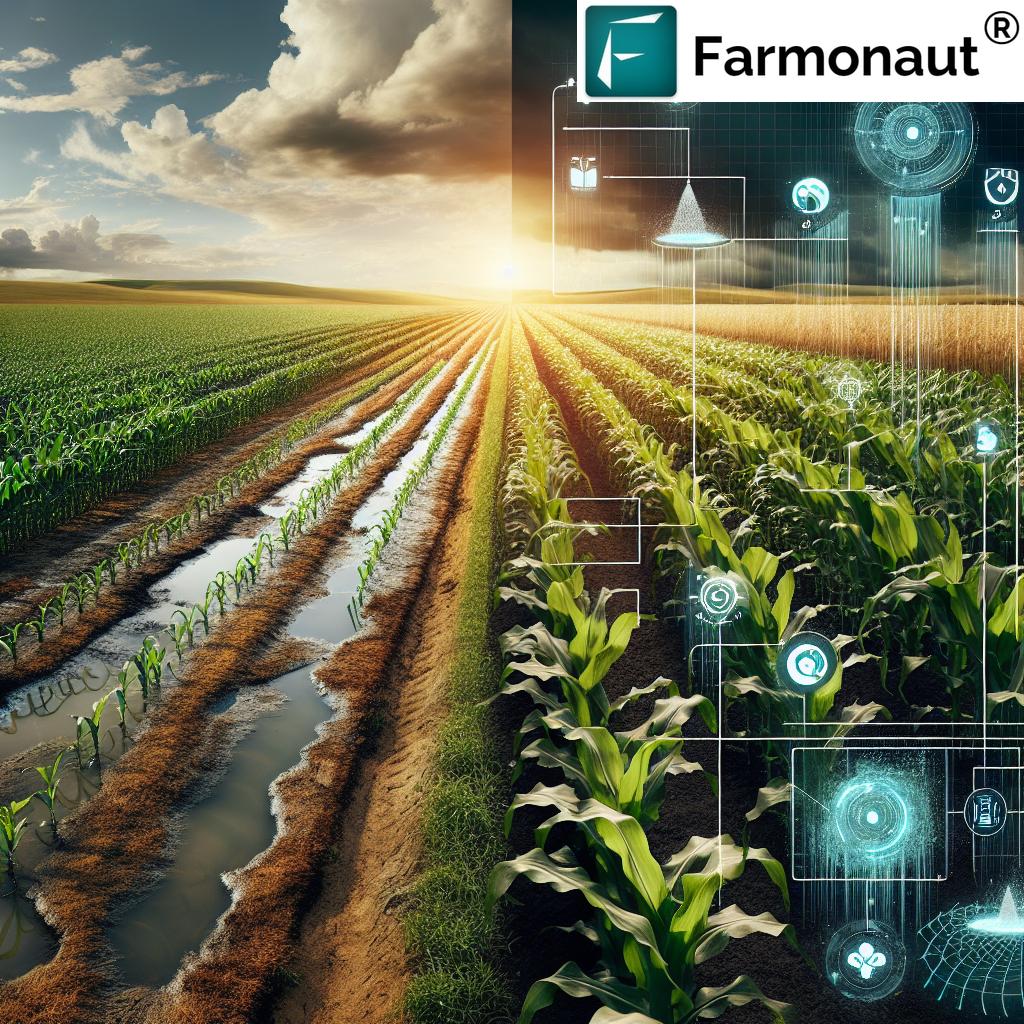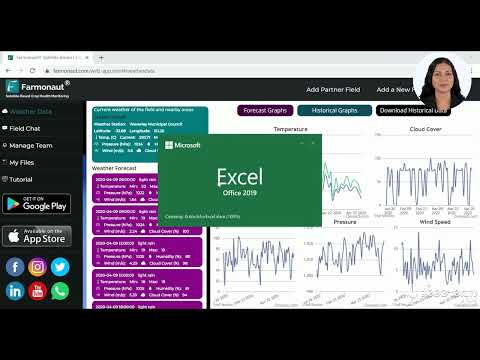2023 U.S. Irrigation Survey: Key Trends in Water Management and Precision Agriculture Technology
“The 2023 U.S. Irrigation Survey reveals a decrease in irrigated acreage and water application across the country.”
Welcome to our comprehensive analysis of the 2023 Irrigation and Water Management Survey, where we delve into the latest trends shaping the landscape of U.S. agricultural water use and sustainable farming practices. As pioneers in precision agriculture technology, we at Farmonaut are excited to share these insights with farmers, policymakers, and industry professionals alike.
In this extensive report, we’ll explore significant shifts in irrigation water management, the adoption of smart farming solutions, and the impact of agricultural data analytics on water conservation in agriculture. Our goal is to provide you with valuable information that can help optimize your farm’s irrigation techniques and keep you at the forefront of precision irrigation innovation.

Overview of the 2023 U.S. Irrigation Survey
The 2023 Irrigation and Water Management Survey, conducted by the National Agricultural Statistics Service (NASS), provides a comprehensive look at irrigation practices across the United States. This survey, which builds upon data from previous years, offers crucial insights into how farmers are adapting to changing environmental conditions and technological advancements.
Key findings from the survey include:
- A notable decrease in total irrigated acreage
- Reduced water application rates per acre
- Increased adoption of advanced sprinkler technologies
- Shifts in regional water use patterns
- Changes in energy expenditures for irrigation
- Growing investments in precision agriculture and smart farming solutions
Let’s dive deeper into each of these trends and explore their implications for the future of agriculture.
Decreasing Irrigated Acreage: A Closer Look
One of the most significant findings from the 2023 survey is the decrease in total irrigated acreage across the United States. This trend reflects a combination of factors, including:
- Improved water management practices
- Adoption of drought-resistant crop varieties
- Shifts in land use and crop selection
- Implementation of more efficient irrigation systems
While a reduction in irrigated land might initially seem concerning, it’s important to note that this trend is often accompanied by increased crop water use efficiency. Farmers are producing more with less water, thanks to advancements in precision agriculture technology and sustainable agriculture practices.
For real-time insights into your farm’s water management, consider using Farmonaut’s satellite-based crop monitoring tools. Access our web app or download our mobile apps:
Water Application Rates: Doing More with Less
The 2023 survey highlights a trend towards reduced water application rates per acre. This encouraging development is a testament to the agriculture industry’s commitment to water conservation and the adoption of precision irrigation techniques. Factors contributing to this trend include:
- Implementation of soil moisture sensors and weather-based irrigation scheduling
- Use of deficit irrigation strategies in appropriate crops
- Adoption of precision agriculture technology for targeted water application
- Improved understanding of crop water requirements through agricultural data analytics
By leveraging these technologies and practices, farmers are not only conserving water but also optimizing their crop yields and reducing operational costs.
Advanced Sprinkler Technologies: The Rise of Precision
“Advanced sprinkler technologies are now utilized on more acres, indicating a shift towards precision agriculture in irrigation systems.”
The 2023 survey reveals a significant increase in the adoption of advanced sprinkler technologies across U.S. farms. This shift represents a move towards more precise and efficient irrigation systems, which offer numerous benefits:
- Improved water distribution uniformity
- Reduced water loss through evaporation and wind drift
- Ability to apply water at rates that match soil infiltration capacity
- Integration with smart farming solutions for automated irrigation management
These advanced systems, often coupled with precision agriculture technology, allow farmers to apply water with unprecedented accuracy, ensuring that crops receive exactly what they need, when they need it.
Interested in implementing precision irrigation on your farm? Explore Farmonaut’s API solutions for integrating satellite data into your irrigation management systems.
Regional Water Use Patterns: A Shifting Landscape
The 2023 Irrigation Survey provides valuable insights into changing regional water use patterns across the United States. Key observations include:
- Shifts in water use intensity in major agricultural states
- Changes in crop selection based on water availability and climate conditions
- Adoption of region-specific water conservation strategies
- Impact of policy changes and water rights on irrigation practices
Understanding these regional trends is crucial for policymakers, water managers, and farmers alike. It allows for more targeted approaches to water management and helps in developing sustainable agriculture practices tailored to local conditions.

Energy Expenditures for Irrigation: Balancing Efficiency and Cost
The 2023 survey also sheds light on changes in energy expenditures related to irrigation. This aspect of farm management is increasingly important as farmers seek to balance water efficiency with energy costs. Key trends include:
- Adoption of energy-efficient pumping systems
- Integration of renewable energy sources for irrigation
- Implementation of variable frequency drives (VFDs) to optimize pump performance
- Use of precision agriculture technology to reduce unnecessary pump runtime
By focusing on energy efficiency in irrigation, farmers can significantly reduce their operational costs while maintaining or even improving their water management practices.
Investments in Precision Agriculture and Smart Farming Solutions
One of the most exciting trends revealed by the 2023 survey is the growing investment in precision agriculture and smart farming solutions. This trend is transforming irrigation management across the U.S. Key aspects include:
- Adoption of IoT-enabled irrigation systems
- Integration of AI and machine learning for predictive irrigation scheduling
- Use of drones and satellite imagery for crop water stress detection
- Implementation of big data analytics for farm-wide water management
These technologies are not only improving water use efficiency but also contributing to overall farm productivity and sustainability.
Explore how Farmonaut’s precision agriculture tools can revolutionize your farm’s water management. Check out our API Developer Docs for integration options.
Crop Water Use Efficiency: The Key to Sustainable Agriculture
Improving crop water use efficiency is at the heart of sustainable agriculture practices, and the 2023 survey indicates significant progress in this area. Farmers are achieving higher yields with less water through:
- Adoption of drought-tolerant crop varieties
- Implementation of conservation tillage practices
- Use of precision irrigation techniques
- Integration of cover crops to improve soil water retention
These practices not only conserve water but also contribute to soil health, reduce erosion, and increase overall farm resilience.
The Role of Agricultural Data Analytics in Water Management
Agricultural data analytics is playing an increasingly crucial role in water management on U.S. farms. The 2023 survey highlights how farmers are leveraging data to make more informed decisions about irrigation. Key applications include:
- Real-time monitoring of soil moisture and crop water stress
- Predictive modeling for irrigation scheduling
- Integration of weather forecasts into irrigation planning
- Analysis of historical data to optimize water use across growing seasons
By harnessing the power of data, farmers can fine-tune their irrigation practices, leading to significant water savings and improved crop yields.
Harness the power of data for your farm with Farmonaut’s advanced analytics tools. Access our web app for comprehensive insights.
Comparative Trends in U.S. Irrigation (2018 vs. 2023)
| Metric | 2018 Value | 2023 Value | Percentage Change |
|---|---|---|---|
| Total Irrigated Acreage | 58 million acres | 54 million acres | -6.9% |
| Average Water Application (acre-feet/acre) | 1.5 | 1.3 | -13.3% |
| Sprinkler Technology Adoption (% of irrigated acres) | 65% | 72% | +10.8% |
| Energy Expenditure for Irrigation ($/acre) | $45 | $50 | +11.1% |
| Smart Farming Technology Adoption (% of farms) | 15% | 25% | +66.7% |
| Regional Water Use – Top 3 States (million acre-feet) | 75 | 70 | -6.7% |
| Crop Water Use Efficiency (yield/acre-foot) | Base | +15% | +15% |
| Investment in Precision Irrigation ($billion) | 2.5 | 3.8 | +52% |
The Future of Water Management in Agriculture
As we look to the future, the trends revealed by the 2023 U.S. Irrigation Survey point towards a more sustainable and technologically advanced agricultural sector. Key areas to watch include:
- Further integration of AI and machine learning in irrigation management
- Development of more drought-resistant crop varieties
- Increased adoption of water-efficient irrigation technologies
- Greater emphasis on water recycling and reuse in agriculture
- Enhanced collaboration between farmers, researchers, and technology providers
These developments promise to further improve water use efficiency, increase crop yields, and contribute to the overall sustainability of U.S. agriculture.
Conclusion: Embracing Innovation for Sustainable Agriculture
The 2023 U.S. Irrigation Survey paints a picture of an agricultural sector in transition, embracing innovation and technology to address the challenges of water scarcity and climate change. As we’ve seen, farmers across the country are adopting precision agriculture techniques, investing in smart farming solutions, and leveraging data analytics to optimize their water use.
These trends not only contribute to water conservation but also improve farm productivity and profitability. By continuing to invest in and adopt these technologies, U.S. agriculture is positioning itself for a more sustainable and resilient future.
At Farmonaut, we’re committed to supporting farmers in this journey towards more efficient and sustainable irrigation practices. Our suite of precision agriculture tools, including satellite-based crop monitoring and AI-driven advisory systems, are designed to help farmers make the most of their water resources.
Ready to transform your farm’s water management? Explore Farmonaut’s solutions today:
FAQ Section
Q: What are the main trends in U.S. irrigation revealed by the 2023 survey?
A: The main trends include a decrease in total irrigated acreage, reduced water application rates, increased adoption of advanced sprinkler technologies, shifts in regional water use patterns, changes in energy expenditures for irrigation, and growing investments in precision agriculture and smart farming solutions.
Q: How is precision agriculture technology impacting irrigation practices?
A: Precision agriculture technology is enabling more efficient water use through real-time monitoring of soil moisture and crop water stress, predictive modeling for irrigation scheduling, and integration of weather forecasts into irrigation planning. This leads to optimized water application and improved crop yields.
Q: What role does agricultural data analytics play in water management?
A: Agricultural data analytics helps farmers make more informed decisions about irrigation by providing insights from real-time monitoring, historical data analysis, and predictive modeling. This allows for fine-tuned irrigation practices, resulting in significant water savings and improved crop yields.
Q: How are farmers improving crop water use efficiency?
A: Farmers are improving crop water use efficiency through the adoption of drought-tolerant crop varieties, implementation of conservation tillage practices, use of precision irrigation techniques, and integration of cover crops to improve soil water retention.
Q: What future developments can we expect in agricultural water management?
A: Future developments are likely to include further integration of AI and machine learning in irrigation management, development of more drought-resistant crop varieties, increased adoption of water-efficient irrigation technologies, greater emphasis on water recycling and reuse, and enhanced collaboration between farmers, researchers, and technology providers.






